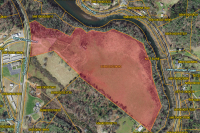Trial by dirt
 While sunlight, water and good soil may seem a simple enough equation for getting a plant from seed to fruit, like anything it becomes a lot more complicated when people are involved.
While sunlight, water and good soil may seem a simple enough equation for getting a plant from seed to fruit, like anything it becomes a lot more complicated when people are involved.
During the past decade, community gardens have been sprouting up across Western North Carolina — from Canton to Cherokee to Sylva. Churches and charity organizations use them as a supply of produce to feed the needy; schools use them as places to teach kids about agriculture and plants; and gardeners use them as social gathering spots and as a source of healthy food.
But each community garden has to cultivate its own unique identity and learn along the way what it takes to persevere season after season, or falter in the field.
Sum of the parts
“To thrive, you’ve got to be organized” is the general mantra used by Phillip Coyle, a gardener in Sylva and professor of anthropology at Western Carolina University. Coyle spends his professional life studying people, their cultures and habits, so it’s hard for him not to have noticed a few things during his five years working alongside fellow gardeners in the Sylva community garden.
Related Items
“It ends up being a group of people, not just a piece of land,” Coyle said.
Even though each gardener has his or her own individual plot — the standard division of space within a community garden — what happens in one plot affects one’s neighbor as well.
A pest problem, neglecting one’s weeding duties, and failure to maintain a given area of the garden can all breed contempt amongst plot companions and create conflict in the garden community as a whole. That is why Coyle believes every successful community garden needs a garden government. One that more resembles a dirt democracy than a soil sultan is preferable, but nonetheless order must be maintained and a strong veg-ecutive branch is usually called for.
“To have a paid garden manager is really important,” Coyle said. “They act as a conductor to keep the gardeners working together.”
If someone claims a plot at the beginning of the season and then fails to follow through or falls behind on upkeep, that is when a manager can step in and force that person to either relinquish the plot to another willing farmer or start giving it more TLC.
You can tell a lot about a community by its garden. And the Sylva garden, Coyle said, tends to err on the side of leniency, and second chances are rampant in the close-knit group of gardeners.
“You don’t want to be too overbearing because people get busy, and then they come back to it,” Coyle said. “You don’t want to exclude and isolate gardeners in the small community.”
And even the iron will of the toughest of cultivators will be tested in the summer, when the flesh becomes weak and reruns of Lost in the air-conditioned living room beckon. July could be the single, most difficult hurdle a gardener has to clear all season.
“It’s hot, buggy and uncomfortable to be out there,” Coyle said. “Everyone loves to garden in the spring when it’s pleasant.”
Cracking the whip on the individual plot holders is one way to maintain order in a community garden. In Sylva, the share-gardeners also pay a “tax” in the form of half their harvest handed over to the Community Table, a local organization that works to feed the needy. Last year, more than 1,000 pounds of produce was donated.
But one community garden in Waynesville, organized by the nonprofit Daydreamz, is pushing the meaning of community. Originally started as one more option for seniors who came for activities scheduled at the old Armory, the garden, which utilizes modified dumpsters as raised beds, has developed a style of its own during the last four years.
“It’s definitely a community garden,” said Pamela Norris, one of the garden’s managers. “It’s not a garden where I have my plot and you have your plot.”
Instead, the volunteers of the garden behind the old Armory make a comprehensive plan, what to plant when and where. Those who show up for work days get a share of the harvest, the rest is donated.
And all types show up, and all types are accepted. And a large number of the people working in the garden during the years have been the elderly or folks with special needs, Norris said. Therefore, on any given day, it’s not unusual to see an eclectic mix tending to the beds.
“Blending a nine-year old with someone in their fifties with Down’s syndrome is a really beautiful mix,” Norris said. “We don’t limit ourselves to who were working with.”
Norris said the garden’s unique style has only attracted a few participants during the years who have not entirely embraced the communal concept — in which every plant is everyone’s, and everybody works together. The skeptics included a vegetable planter who was protective of his hanging tomatoes and another rogue squash gardener who didn’t seem to interested in working with the ragtag crew.
“He went ahead and planted squash plants in the corner and made it clear to everybody that they were his squash plants,” Norris said. “We just kind of let him be. We felt awkward that year.”
It may seem simple enough, but one of the foundations of a stable community garden is land tenure — simple to understand, when compared to the intricacies of mastering a garden, but sometimes harder to achieve.
Sylva’s community garden sits on a parcel of private property donated for the time being by the land’s owner. The land has a high property value, and many fear that the day will come when the scenic spot along Scott Creek is yanked out from under them.
In the Almond community of Swain County, the gardeners had to learn the hard way how tenuous the link between the garden and borrowed land can be. While looking around for a suitable site to start a community garden in 2008, Christine Bredenkamp, a horticulturist with the N.C. Cooperative Extension, located an abandoned baseball field at the Southwestern Community College campus.
Unlike other places Bredenkamp had examined, the Almond site seemed to fit the bill, and an agreement was worked out to open the field up as a community garden. The first season, some of the gardeners were able to take multiple sections.
By the second year, a waiting list had developed, the soil on the ballfield had been painstakingly improved for cultivation and familiarity with the site had set in.
“Almond evolved as a good community garden,” Bredenkamp said.
While it had it’s share of run-of-the-mill garden disputes — such as organic versus Miracle Grow — the membership had regulars meetings, potlucks and a system for confronting issues that arose. But no amount of weeding, extra compost or conflict resolution was enough to prevent its loss of land.
Last spring, SCC notified the group of residents that they could no longer garden there that coming fall. The college has plans to use the space for an outdoor leadership program equipped with a ropes course, rescue skills instruction and storage places for kayaks and canoes.
“We moved the arts program to that center,” said facility development director Chuck Reece about the Almond campus. “And now space is at a premium.”
As well intentioned SCC’s plans were, it still meant the Almond gardeners have to pick up and start over. And with spring here, time is running out to find another site with adequate sunlight, space and water and in close proximity so that the former gardeners won’t have to travel too far. Several group gardens already exist in area, but some are associated with a certain church or are too far away.
Bredenkamp still holds faith that summer vegetable planting could occur at a newfound site this season.
“We’re getting kind of late, but there’s still hope,” she said. “If a site can be found, tilled up, and lime and manure compost brought in and added, people could still get going.”
But as gardens have come and gone during the years in WNC, the gardens in Cherokee have been a mainstay of the people’s diet and a cornerstone of their culture. As gardeners for thousands of years, the Cherokee are the original agriculturalists of the Appalachians.
Currently, community gardening in Cherokee enjoys the land stability offered by a tribally administered program. About 250 acres of tribally owned land is leased annually to families who apply for acreage. The plots vary in size from small hay farms to little subsistence gardens and about 50 families or so harvest on the public land, said Sarah McClellan-Welch, an agricultural agent in Cherokee.
And the public land, dedicated to agriculture, carries the assurance that it will be there year after year.
“Having a stable place is critical,” McClellan-Welch said. “Farming and gardening is habit; it takes time to learn the climate, get the soil into shape and learn when and how to get to the garden.”
But most of the gardens in Cherokee are on private land and worked by groups of families, neighbors or civic organizations. McClellan-Welch said the local cooperative extension office also provides mobile support to those gardens, bringing out a trailer with essential supplies for community work days as well as activities for the kids.
McClellan-Welch said many of the Cherokee gardens contain plants that have been part of their traditional diet and bringing them to fruit is not just a pastime for tribal members.
“Our economy is in bad shape,” McClellan-Welch said. “So people do everything they can to be self-sufficient.”
A growing phenomenon
During the past decade, community gardens have greened the landscape in WNC, appearing in all shapes, sizes and for all purposes. This year, at least two more gardens are being added to mix: one in the Cowee community in Macon County and another in Cullowhee.
The Cullowhee community garden will be located on county-owned land along Cullowhee Creek, right before it empties into the Tuckasegee River. The one-acre garden will be divided into 65 plots and irrigated by a solar-powered pump. The site is also the planned trailhead of the county’s future greenway.
The garden’s manager, Adam Bigelow, could barely hold back his excitement in anticipation of its inaugural year. Bigelow also has a plot in the Sylva community garden. But he had a vision for another garden in Cullowhee, a bigger one, on public land.
“I built my dream garden,” Bigelow said.
After making a pitch to county commissioners for the land and being awarded a nearly $40,000 grant for the project through the Jackson County Health Department, Bigelow is now acquiring tools and preparing the property for the planting season. Already, residents are approaching him with interest in having a plot.
Yet, even Bigelow understands that the momentum and outside money and support carrying the Cullowhee Community garden in its infancy is much like the enthusiasm felt by gardeners in the spring — it will subside a bit with time. He has decided to invest in tools and improvements to the property that will last and do it right the first time.
Once up and running, community gardens can operate on little to nothing. The Sylva community garden keeps afloat on about $600 per year, Bigelow said.
“There’s a lot of funding and support to start a new garden,” Bigelow said. “But there’s not a lot to keep it going.”
But Bigelow dreams big. His 65 garden plots of 15 feet by 30 feet are on a much larger scale than 10 beds of four feet by 12 feet that Susan Ervin has planned for her little community garden in the yard of the Cowee community center, formerly a shuttered school house.
As her garden project ramps up, Ervin is hoping it will draw locals who don’t want to make the 10-mile trip into Franklin to maintain a plot in the community garden along the greenway. Instead, Ervin is offering short commutes, good soil and most importantly good times for residents without good garden locales on their own property.
“Maybe they’ve tried gardening and either have too much shade or red clay,” Ervin said. “This is going to be good soil; you’re not fighting against the odds.”









